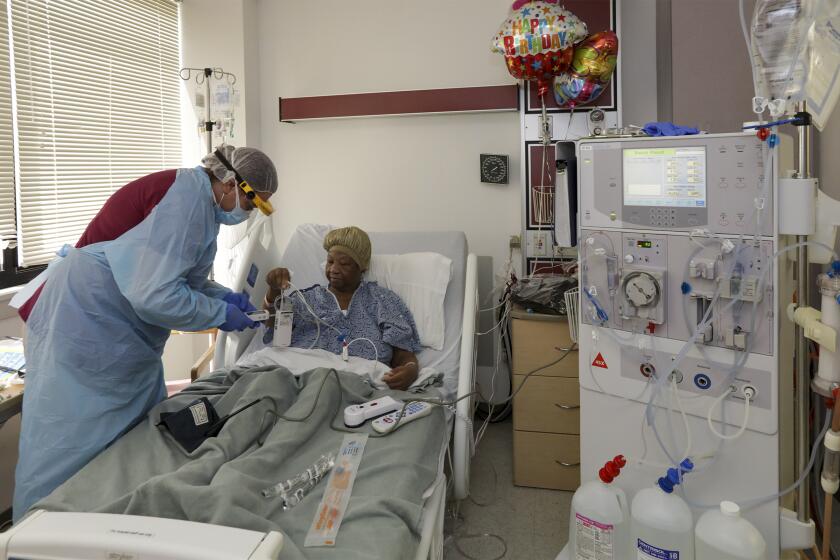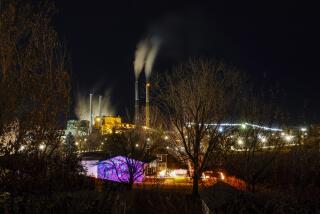As COVID-19 renews interest in radiation, doctors caution against radon-filled mines
- Share via
BOULDER, Mont. — Twice a year, Brian Tichenor makes the 1,200-mile drive each way from his home in Kansas to a defunct uranium mine in Montana, where he takes an elevator 85 feet below the surface to sit amid radioactive radon gas to ease the pain from his chronic eye condition.
“I found it like I think a lot of people do,” said Tichenor, 67. “It’s a point of desperation with conventional treatment.”
While radon is commonly known as a hazardous gas removed from basements, people in pain travel to Montana and pay to breathe, drink and bathe in its radioactive particles. The travelers view the radon exposure as low-dose radiation therapy for a long list of health issues.
But the Environmental Protection Agency and the World Health Organization, among others, blame the gas as the second-leading cause of lung cancer. Although oncologists use radiation as a front-line treatment to destroy cancer cells, its role in the U.S. in low doses for other ailments is disputed.
The pandemic has recharged that debate as clinical trials across the world test whether low doses of radiation can help treat patients with COVID-19. But radon gas isn’t the same radiation U.S. doctors use, experts caution.
Radon is just one of the radioactive chemical elements and, because it’s a gas, it can be inhaled, making it particularly dangerous. Sitting in a radon-filled room and receiving targeted radiation treatment in a medical facility are as different as “chalk and cheese,” said Brian Marples, a professor of radiation oncology at the University of Rochester.
“In clinical therapy, we know exactly what the dose is, we know exactly where it’s going,” he said.
Marples said much of the argument for radon’s therapeutic use relies on historical reports, unlike evidence-based research on clinical radiation. Still, some radiation experts are split on what level of radon should be deemed dangerous or whether it could have positive health effects.
Another concern: The radon treatment in the mines is largely unregulated. The Montana Department of Public Health and Human Services doesn’t have the authority to permit or license the mines, though department spokesperson Jon Ebelt said the adverse health risk from exposure is well known. The EPA also lacks the power to mandate limits on radon.
So travelers head to western Montana, where four inactive mines flush with radon are within 11 miles of one another near the rural communities of Basin and Boulder. Day passes range from $7 to $15. The gas naturally forms when radioactive elements in the mountains’ bedrock decay.
Outside the Merry Widow Health Mine, a billboard-like banner announces “Fountain of Youth. FEEL YOUNG AGAIN!” Inside its tunnels, water seeps from the rock walls. Those who want full immersion can slip into a clawfoot tub filled with radon-tainted water. People soak their feet and hands in water or simply sit and work on a puzzle.
On a bench sits a printout of a Forbes article on clinical trials that show low-dose radiation could be a treatment for COVID-19.
To owner Chang Kim, 69, his business is a mission, especially for those with chronic medical conditions such as arthritis or diabetes. Those who swear by radon therapy say that, in low doses, a little stress on the body triggers the immune system to readapt and reduces inflammation.
“The people coming to the mines, they’re not stupid,” Kim said. “People’s lives are made better by them.”
He learned about the mines 14 years ago when he and his wife, Veronica Kim, lived in Seattle and a connective tissue disease crumpled Veronica’s hands and feet. Traditional medicine wasn’t working. After two sessions a year in the mines ever since, Veronica smiles when she shows her hands.
“They’re not deformed anymore,” she said, adding she’s been able to cut down on her use of meloxicam, a medication to reduce pain and swelling.
It may seem like biotech companies are focused solely on developing vaccines for COVID-19, but some are hard at work on drugs that could treat those who become sick.
Tichenor said going to a mine with radon over six years has been one of the few things to calm his scleritis, a disorder that causes pain he describes as ice picks stabbing his eyes. As for its potential danger, he said radon treatment is just like any medication: Too much can cause harm.
He and other radon users point to European countries such as Germany, where the therapy may be controversial but doctors still can prescribe radon treatments for various conditions that insurance may even cover.
In the U.S., the EPA maintains that no level of radon exposure is risk-free even though everyone encounters the element in their lives. The agency notes radon is responsible for about 21,000 lung cancer deaths every year. It recommends that homeowners with radon levels of 4 picocuries per liter or more should install a radon-reduction system.
By contrast, the owners of Montana’s oldest radon therapy mine, Free Enterprise Radon Health Mine, said their mine averages around 1,700.
Monique Mandali said the federal guidelines are “a bunch of baloney.” Mandali lives in Helena, about 40 minutes from the mines, and tries to fit in three sessions at Free Enterprise a year — 25 hours of exposure spread out over 10 days for arthritis in her back.
“People say, ‘Well, you know, but you could get lung cancer.’ And I respond, ‘I’m 74, who cares at this point?’” she said. “I’d rather take my chances with radon in terms of living with arthritis than with other Western medication.”
Antone Brooks, formerly a U.S. Department of Energy scientist who studied low-dose radiation, is among those who believe that the federal government’s no-safe-level-of-radon-exposure stance goes too far. He pointed to research that indicates low doses of radiation potentially turn on pathways within bodies that could be protective. Though what’s considered a “low dose” depends on who’s talking.
“If you want to go into a radon mine twice a year, I’d say, ‘OK, that’s not too much,’” he said. “If you want to live down there, I’d say that’s too much.”
Scientists have found 13 places in the human genome that may influence our susceptibility to a coronavirus infection or risk of severe COVID-19.
In the early 1900s, before antibiotics were popularized, small doses of radiation were used to treat pneumonia with reports it relieved respiratory symptoms. Since then, fear has largely kept the therapeutic potential of low-dose radiation untapped, said Dr. Mohammad Khan, an associate professor with the Winship Cancer Institute at Emory University.
But amid the pandemic, healthcare providers struggling to find treatments as hospital patients lie dying have been giving clinical radiation another look. So far, the trials Khan has led show that patients who received targeted low-dose radiation to their lungs got off oxygen and out of the hospital sooner than those without the treatment. Khan said more research is necessary, but it could eventually expand clinical radiation’s role for other illnesses.
“Some people think all radiation is the same thing, that all radiation is like the Hiroshima, Nagasaki bombs, but that’s clearly not the case,” Khan said. “If you put radiation in the hands of the experts and the right people — we use it wisely, we use it carefully — that balances risk and benefits.”
The logo for Free Enterprise Radon Health Mine is a miner skipping with crutches in the air. Roughly 70 years ago, a woman said her bursitis disappeared after visiting the mine several times. Thousands of others followed suit.
“We believe in it,” said Leah Lewis, who co-owns the mine with her husband, Ryan Lewis, and who has relied on it to help treat her Crohn’s disease.
A new study adds to the growing body of evidence that the pandemic’s true toll is far greater than official tallies show.
The couple live on-site and grew up in Boulder, going into the tunnels just as their 5-year-old daughter does now. Her husband’s great-grandfather owned the mine, and the business has been in the family ever since.
“Not one person has come back and said they’ve gotten lung cancer here,” Ryan Lewis said. “If they did, they would shut us down so fast.”
Aside from a billboard outside Helena, the family doesn’t really advertise the business. Clients tend to find them. Like many companies, Ryan Lewis said, Free Enterprise took a hit last year as people canceled plans due to the pandemic. Before that, the business broke about even, he said, adding that radon can be “a hard sell.”
But he said the family of cattle ranchers plans to keep it running as long as it doesn’t cost them money.
“The land is an investment, and we want to keep it in the family,” he said. “And there are a lot of people who use this, and there’s some responsibility there.”
KHN (Kaiser Health News) is a national newsroom that produces in-depth journalism about health issues. Together with Policy Analysis and Polling, KHN is one of the three major operating programs at KFF (Kaiser Family Foundation). KFF is an endowed nonprofit organization providing information on health issues to the nation.








